If the minimum number of participants is not reached, the tour may be cancelled.
Any charge or additional applications may be available at the on-site tour desk. However, we highly recommend that participants apply for the tour in advance to help us organize a better tour for everyone.
PCT-1: Seoul Tour
| Time & Date | April 10(Tue)-12(Thu), 2012 / 2N 3D |
|---|---|
| Price | KRW 620,000/person (Min. 20 Pax) |
| Itinerary |
D1: N Seoul Tower – Cheongyecheon Steam – Lunch - Cheonggye Stream – Gyeongbokgung Palace - Deoksugung Palace(Guard-changing Ceremony) – Hangang River (Ferry Cruise) D2: War Memorial Museum – National Museum of Korea – Lunch – Insadong Antique Shop Alley - Namdaemun Market – Namsan Hanok Village D3: Digitalpavilion – Korea House(Gimchi Making Experience) – Itaewon |
| Conditions |
- Accommodation: Twin room sharing at 4 star hotel(or similar), extra charge for single occupancy is KRW 180,000. - Including breakfast at the hotel & lunch at local restaurant for 2nd, 3rd days (Excluding dinner) - Including Transportation in Seoul by bus - Including English speaking guide ※ Details will be informed later when the tour is confirmed. |
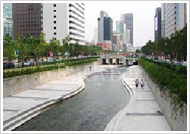
Cheonggye Stream, flowing through the central part of Seoul, is a variety of fun activities and delicious eateries open to the public. Museums, a palace, and outdoor cafes and restaurants surround the starting point of Cheonggyecheon. You can walk around Seoul’s central area, and also go on a tour led by a cultural heritage commentator.

Gyeongbokgung Palace was built as the primary palace of the Chosun Kingdom by its founder, King Taejo in 1395, and it has a meaning of "shining happiness". Keunjeong-jeon, the royal throne hall is Korea's largest surviving wooden structure. Kings conducted state affairs, held official functions, and received foreign envoys here.
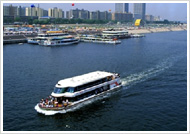
Hangang River, a symbol of Seoul, runs through Seoul from east to west with an average width of 175 m. Hangang River Ferry Cruise is one of the best ways to enjoy the scenery around Hangang River that flows through Seoul. Cool wind from the river, the surrounding scenery, which get more beautiful in the evenings, are the rewards the ferry cruise can offer you.
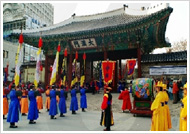
Deoksugung Palace has held a guard-changing ceremony since 1996 after thorough historical research by leading historians. The ceremony, which is held in front of the Daehanmun Gate of Deoksugung Palace, is a tradition similar to the Changing of the Guards at Buckingham Palace and offers a rare opportunity to experience royal culture. The royal gate is opened and closed at pre-determined times, and the gatekeepers in charge of guard duty and patrols hold a shift ceremony three times a day.

War Memorial Museum has 6 display rooms showing an almost 5,000-year history of foreign invasions, from before the Three Kingdoms Period through the Korean War. The park surrounding the museum is filled with aircraft, tanks, and other fighting machines from the Korean War to the present.
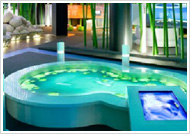
Digitalpavilion promotes Korea's IT industry's status and new technologies and products. The Digitalpavilion has been performing functions and roles representing Korea at IT exhibition hall where it has over 150,000 international visitors and VIPs every year. The Digitalpavilion is a multi-exhibition hall where it consists of the latest technology, products and a lifestyle that is connected with the world of the future. Visitors can experience the new and wonderful future life by looking, touching and utilizing the latest products. Moreover, Digitalpavilion provides IT field trips and education programs with real life experiences for children who will become human resources in the future IT industry.
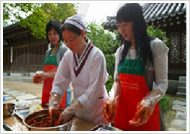
Korea House was built to promote traditional Korean culture among both Koreans and foreigners. Once the private residence of Park Paeng-nyeon, a Joseon Dynasty scholar, that had been renovated with architectural features of an ancient court before opening to the public in 1981. The idyllic premises play host to a variety of cultural programs designed for experiencing various Korean traditions, ranging from food and arts to tea etiquette and wedding ceremonies.

Itawon is one of the most popular shopping districts in Seoul, particularly among visitors. The densely packed shops in the area sell leather clothes, t-shirts, suits, watches, bags, shoes and accessories and much more.
|
|
PCT-2: Jeju Island Tour
| Time & Date | April 17(Tue)-19(Thu), 2012 / 2N 3D |
|---|---|
| Price | KRW 630,000/person (Min. 20 Pax) |
| Conditions |
- Accommodation: Twin room sharing at 4 star hotel(or similar), extra charge for single occupancy is KRW 180,000. - Excluding domestic air flight between Seoul and Jeju - Including breakfast at the hotel & lunch at local restaurant for 2nd, 3rd days (Excluding dinner) - Including Transportation in Jeju by bus - Including English speaking guide ※ Details will be informed later when the tour is confirmed. |
| Itinerary |
D1: Cheojiyeon Water Fall - Olle(Walking Path)- The Jeju International Peace Center – Jeju Circus World D2: Jumbo Village (Elephant Show) - Glass Catsle – Lunch – Mt. Sanbang & Yongmeori Coast - Jeju Folklore & Natural History Museum - Samseonghyeol D3: Jeju Jeolmul Natural Recreation Forest – Sunyeo and Namuggun (Fairy and Woodcutter) Them Park –Lunch – Seongsan Ilchulbong Peak – Pony Trekking - Souvenir Shop |
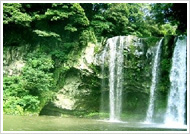
Cheonjiyon, meaning ‘the heaven and the earth meet and create a pond’. At 22 m in height and 12 min width, the waterfall tumbles down to the pond to produce awe-inspiring scenery. The valley near the waterfall is home to Elaeocarpus sylvestrisvar, ellipticus, which is Natural Monument No. 163, Psilotum nudum, Castanopsis cuspidatavar sieboldii, Xylosma congestum, Camellia and other subtropical trees. This place is also famous as home to the eel of Anguilla Mauritian, which is Natural Monument No. 27 and is active primarily at night.
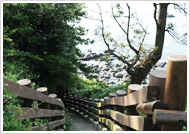
Olle was originally used to refer to the narrow path between the street and one's doorstep in the local Jeju dialect. For the global traveler looking for a unique destination, the olle walking paths on Jeju Island are highly appealing. These are 200km of connecting paths that will take travelers all along the south coast of Jeju Island. The paths are connected, and the route is divided into twelve sections, which will take you through along forests, beaches, and villages, where you can meet the warmhearted local people.

The Jeju International Peace Center exhibits north and south peace exchanges between international peace activists, as well as Nobel Peace Prize winners, and the works of people who have helped Korea. After the Korean government declared Jeju Island an "island of world peace," it has since been trying to maintain its peaceful image, and has had an International Peace Center built.

Jeju Glass Castle is a glass art theme park featuring an exhibition hall, garden and models all made entirely out of glass. There are six themed model parks, in which over two hundred and fifty models are exhibited. These include the world's very first all-glass labyrinth, the world’s largest glass ball and largest glass diamond, a glass stonewall, a mirror lake, and a glass bridge. There are also glass art masterpieces by internationally famous artists from Italy, the Czech Republic, Japan, and more.

Mt. Sanbangsan is the result of violent volcanic activity some 700,000 to 800,000 years ago and is in fact a huge body of lava. The cliffs on the southern side of the lava dome are marked with a rich variety of curious formations such as weathering pits and talus scree slopes, some of which are as high as 200m. As its name 'sanbang' - literally meaning 'a cave inside a mountain' – suggests, this mountain contains a cave, which is located about 150m above sea level and has a spectacular view out over the ocean.

Jeju Folklore & Natural History Museum currently has on exhibition folklore remains and natural historical materials of Jeju-do that were excavated in Jeju-do and displayed in 1984. The Natural History Exhibition Hall displays mainly natural historical items such as marine life, soil and rocks, and fauna and flora of Jeju in a three-dimensional way. It gives visitors a better understanding of Jeju’s unique nature and culture. It is divided into an Ecology Hall of Marine Life, a Soil and Rock Exhibition Hall, and a Land Ecosystem Hall.

Samseonghyeol, designated as Historic Site No.134, is located in the pine forest, the word "Samseonghyeol" means "three clans' holes", referring to the three '品' shaped holes in the middle of the forest. Each hole is separated from the other holes by a few meters. Samseonghyeol is the place where three demigods, the founding fathers of Tamna (the former name of Jeju), first appeared. The three princesses brought with them a calf, pony, and five different seeds that eventually helped to establish agriculture in Jeju.

Jeju Jeolmul Natural Recreation Forest in Jeju Island is located northeast of Hallasan Mountain. Jeolmuloreum is famous for its beautiful Japanese cedar forest. Jeolmuloreum is about 650m high above the sea level and created by volcanic activity. The peak of Jeolmuloreum boasts amazing view. It is even possible, during the clear weather, to see Ilchulbong Sacred Mountain.
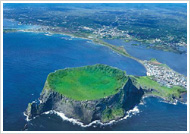
Seongsan Ilchulbong Peak(Sungsan Sunrise Peak) Many tourists regard Seongsan Ilchulbong Peak as the most impressive tourist site in Jeju Island. It should be, however, noted that people who haven't seen the sun rise still choose the site as the best place.
|
|
PCT-3: Namhae Tour
| Time & Date | April 17(Tue)-19(Thu), 2012 / 2N 3D |
|---|---|
| Price | KRW 600,000/person (Min. 20 Pax) |
| Conditions |
- Accommodation: Twin room sharing at 4 star hotel(or similar), extra charge for single occupancy is KRW 180,000. - Including breakfast at the hotel & lunch at local restaurant for 2nd, 3rd days (Excluding dinner) - Including Transportation from Busan to Namhae by bus - Including English speaking guide Details will be informed later when the tour is confirmed. |
| Itinerary |
D1: House of Changwon – Lunch – Namhae Bridge - Chungnyeolsa Shrine - Gwaneumpo – Mt. Mangun – Hwabangsa Temple D2: Geumsan Boriam – Lunch – Ferry Cruise - bamboo weirs - Namhae Butterfly Park D3: Mud Flat Experience – Lunch – House and Garden – German Village |

House of Changwon, Once home of a renowned local Neo- Confucian scholar named Ducheol (a.k.a. Toeeun), a 5th-generation ancestor of An Taek-yeong, this house is now used as a learning center for traditional lifestyle and culture. Built on a site of 10,209 , the house contains 14 buildings including those exhibiting collections of farming tools, now this traditional-style house is used for studying traditional Korean culture and custom and there are fourteen buildings and traditional farming equipment

Chungnyeolsa Shrine was established to embody the spirit of Admiral “Chungmugong” (honorific title in military) Yi Sun-Sin. He was a great national hero who led the Korean navy to victory in many naval battles using innovative ‘turtle ships’ against the Japanese during their failed invasion of Korea during the 25th year of King Seonjo of the Joseon Dynasty (1592).
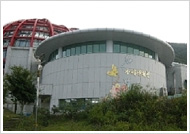
The Butterfly Ecology Hall in the Namhae Butterfly Park is a large, butterfly-shaped architecture. It consists of Exhibition Halls No. 1/No. 2, the Butterfly Greenhouse, Experience Learning Center, and Sample Exhibition Hall. In addition, there is a Butterfly Breeding Room and a Botanical House outside providing visitors with an opportunity to get family together with a variety of butterflies and insects.

German Village was built to accommodate Korean expatriates who left the country in the 1960s and 70s to work as nurses and miners in West Germany. A lot of them married Germans, some of the Koreans resettled here in the hope of starting their second lives in their home country. The village has now been developed into a tourist site where visitors can experience German culture.
|
|










 >
Tour
> Pre/Post Congress Tours
>
Tour
> Pre/Post Congress Tours
